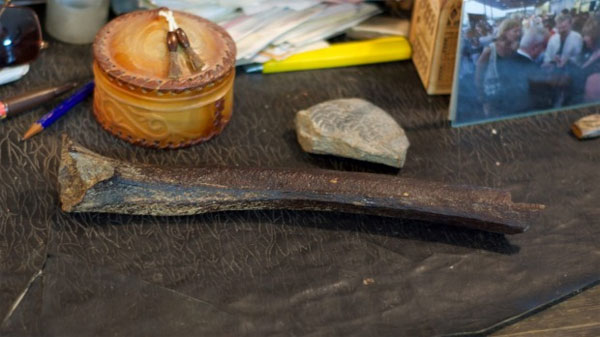Successfully decoding the genome of a 45,000-year-old man
Scientists have successfully deciphered the genome of a man who lived 45,000 years ago. This is also the oldest man ever discovered in the modern world.
>>>The first complete map of human gene activity
>>> Decoding the world's longest living human gene
"We previously deciphered the genome of a Mal'ta boy dating back to 24,000 years" and this time quality, " geneticist Janet Kelso of Max Planck Institute said. of the genome Kelso tried to replicate "well equivalent to modern human genomes".
Researchers took bone samples from a femur bone found in 2008 on the banks of the Irtysh River, near Ust'-Ishim settlement, Siberia. They used collagen from bone to determine the age and DNA samples to sequence this man's genome. When the sequence was complete, they were able to compare it to the modern human genome and find mutations in the Ust'-Ishim man's genome.

The thigh bone of a Ust'-Ishim man.
According to Kelso: "Once we learned that this Ust'-Ishim lived 45,000 years ago, we were able to calculate how many mutations accumulated each year by region. As a result, we found 1 to 2 mutations accumulated on the genome of people living in Europe and Asia since the time of the Ust'-Ishim man so far ".
The mapping of a 45,000-year-old man's genome will help researchers better understand the relationship between ancient Ust'-Ishim people and modern people."We found that the ancient Ust'-Ishim had a close relationship with modern Asians and early Europeans , " Kelso said. This means that the residential community this man belongs to may have split into Europe and Asia almost at the same time or not long before, these two groups split from a large group.
If the hypothesis is correct, then it is likely that the Siberians have "failed when their children and grandchildren exist in the modern community" , according to the researchers. Moreover, the presence of a group of people in Siberia 45,000 years ago showed that the migration of people to the Eurasian region is not limited to the south as the previous predictions.

Neandethal people.
However, the Ust'-Ishim man's genome also revealed many other secrets. Specifically, this genome contains longer Neanderthal DNA parts than our genome today. Kelso said this suggests that our Neanderthal DNA portion was longer than it is now but has been reduced in size over generations. In addition, the determination of bone age and complete genome reconstruction help researchers determine the time of the ancestor of this ancient man to cross Neanderthals.
Previous predictions suggest that the time between the two breeds may have been between 37,000 and 86,000 years ago, but Kelso and his colleagues believe that the event may have occurred between 50,000 and 60,000 years ago or roughly from 7,000. up to 13,000 years before the aforementioned Ust'-Irish man was born.
According to Kelso, the genome offers a new, more independent way to estimate the mutation rate of people over time. Often, researchers will use genealogy - a method that allows researchers to count mutations between closely related species or estimate errors in the process of copying DNA to confirm determine the rate of mutation. Now, the genome can help researchers re-examine their estimates. Kelso said the genomes were provided as public resources and he hoped to better understand the history of modern humans through the genome.
- Scientists successfully decode the spider's genome
- Successfully decode the genome of soybeans
- The first successful decoding of the tomato genome
- US science successfully decodes the genome of wheat
- The first successful decoding of the wheat genome structure
- Wukong recognizes the benefits of decoding human genes
- Vietnam first deciphered the rice genome for the first time
- Science successfully deciphered the hookworm genome
- Complete dog genome decoding helps to understand more about human disease
- Decode the genome bamboo Moso
- For the first time, Vietnam has successfully built the Vietnamese genome
- Decode the 115-year-old woman's genome
 Discovered an ancient centipede fossil 99 million years old
Discovered an ancient centipede fossil 99 million years old Discovered bat-like dinosaurs in China
Discovered bat-like dinosaurs in China Discovered a 200-year-old bronze cannon of the coast
Discovered a 200-year-old bronze cannon of the coast Discover 305 million-year-old spider fossils
Discover 305 million-year-old spider fossils Scientists publish first complete human genome
Scientists publish first complete human genome  Will humans be able to regrow limbs like the 'Tiger beetle'?
Will humans be able to regrow limbs like the 'Tiger beetle'?  Research on the Vietnamese genome found many rare diseases
Research on the Vietnamese genome found many rare diseases  International publication of the Vietnamese genome sequence
International publication of the Vietnamese genome sequence  Great turning point: People have 'programmed' bacteria
Great turning point: People have 'programmed' bacteria  Humans are evolving from natural selection to intellectual selection
Humans are evolving from natural selection to intellectual selection 